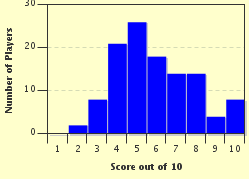Quiz Answer Key and Fun Facts
1. Every school child learns that the ancient Egyptians wrote on a type of paper called papyrus. In which of the following forms were papyrus documents typically made?
2. The ancient Egyptians created a 365-day calendar that served as a model for many subsequent peoples. How many months were included in the ancient Egyptian calendar?
3. Which of the following architectural pieces may have been used by the ancient Egyptians to also keep track of time?
4. Although ancient Egyptian shadow clocks were accurate, they were not useful at night or whenever it was cloudy. Which of the following was the earliest alternate type of time piece that was used?
5. Of course, the ancient Egyptians were able to domesticate crops in the fertile Nile River Valley. They had to, however, devise a way to store and move water when the flood waters receded. What was the name of the device that was used to move water to irrigation ditches?
6. Hippocrates is often called the "Father of Medicine". However, centuries earlier a priest from ancient Egypt is believed to have been the world's first known physician. What was his name?
7. The Egyptians were skillful mathematicians, and used their knowledge of geometry to build spectacular monumental structures. What was, however, probably the original use for geometry in ancient Egypt?
8. Cuneiform in ancient Mesopotamia and hieroglyphics in ancient Egypt are believed to have been independently developed in approximately 3200 BC. The ancient Egyptians went on to develop other types of writing, even though they continued to use hieroglyphics for religious and official documents. Which of the following types of writing did they use for less formal documents?
9. The ancient Egyptians had terrible dental problems due in part to the difficulty of keeping the grains of sand out of their food. Many historians believe they created the first breath mint. Which of the following ingredients was NOT part of their recipe?
10. The ancient Egyptians are well-known for popularizing the use of eye makeup. It was not, however, used purely for cosmetic reasons. Which of the following is NOT an explanation of why both men and women in ancient Egypt applied eye makeup?
Source: Author
ponycargirl
This quiz was reviewed by FunTrivia editor
bloomsby before going online.
Any errors found in FunTrivia content are routinely corrected through our feedback system.

